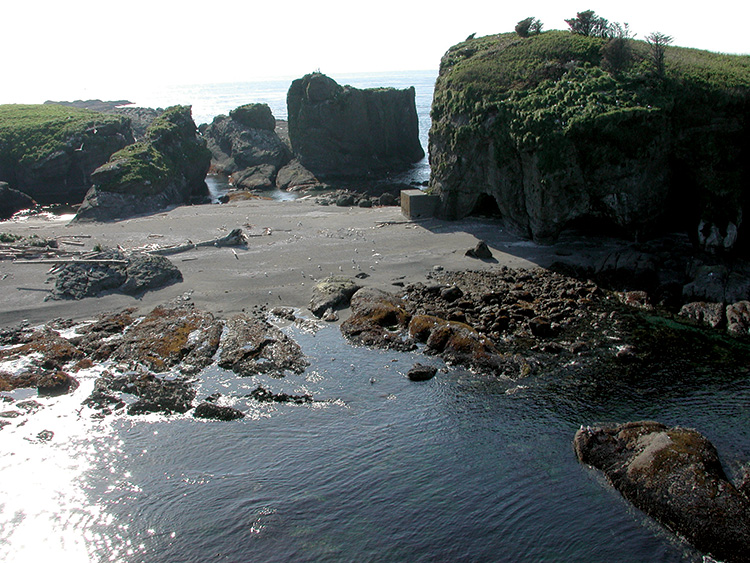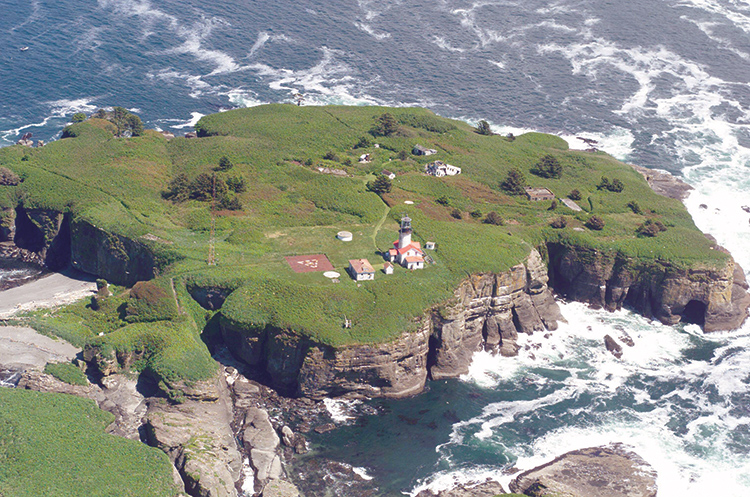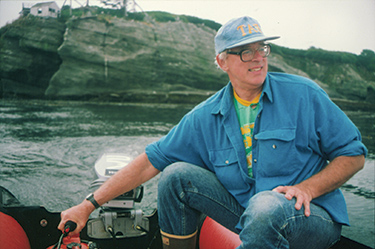For a quarter-century, whenever Robert Paine visited Tatoosh Island, his routine was always the same. At low tide, he would go down to a slope of rock, nicknamed “the Glacier.” Stepping carefully over the mussel bed, he would pry all the starfish he could find from their prime feeding ground, then dump them unceremoniously into the Pacific.
After a short while, Paine would be sweating inside his rain gear and rubber boots. His thick, square glasses were often blurred by salt spray and rain — the windswept island off Washington’s Cape Flattery gets an average of 100 inches of rain a year. But he would not stop until the mussel bed had been picked clean of the starfish, a large, bright-orange or purple species known as the ochre sea star.
Sometimes there were a hundred or more to remove. For a time, whenever Paine handled the starfish, the skin would peel off the tips of his fingers — possibly an allergic reaction. He has tossed away thousands of starfish in his lifetime.
Such behavior might seem bullheaded or outright nutty, but in reality what Paine was doing was just good science. Throwing starfish was part of one of the longest marine ecological experiments ever conducted, a 25-year investigation of how the loss of a top predator would affect the rest of the rocky intertidal ecosystem. Such work has made Paine, now a professor emeritus of biology at the UW, one of ecology’s most prominent thinkers, honored by the Ecological Society of America, the American Society of Naturalists and the British Ecological Society.
His fame rests on two major scientific achievements: investigating how interactions between species hold the strands of food webs together — especially his development of the “keystone species” concept — and moving ecology from passive observation to active experimentation in natural environments. For nearly four decades, Tatoosh Island has been the living laboratory where Paine has developed and refined his achievements.

It is a forbidding place. The 20-acre island sits where the Strait of Juan de Fuca meets the Pacific. Traveling northwest, it is the last piece of land in the “Lower 48,” subject to gales with winds that can reach 100 miles an hour. In winter, when 25-foot waves are common, the only way to get there is by helicopter.
Yet the island also possesses an extraordinarily diverse intertidal environment. In addition to its abundant marine life, the island has a major seabird nesting colony and is a stopover point for migratory birds. “It’s a handsome spot,” says Paine, who began working on the island in 1968. “It’s a spot I know and love, and it’s packed with all kinds of interesting biology.”
Tatoosh was once the site of a Makah summer village, where tribal members dried racks of fresh-caught fish and launched whaling canoes. A lighthouse, guiding mariners through the perilous entrance to the strait, began operating in 1857. In the early 20th century, the federal government had a weather station on the island. During World War II, the Navy used it to listen to Japanese radio transmissions.
Today, the Makah, who own the island, allow few outsiders to visit. This isolation, and the stretch of rough water separating the island from Cape Flattery, ensures that the environment remains pristine and experiments can run unmolested. By giving the scientists access to the island over nearly four decades, the Makah have made possible long-term ecological studies that are vitally important but rarely possible.
Over the course of 37 years, Paine and a shifting community of students and colleagues have studied nearly every major group of the island’s intertidal species — sea anemones, sponges and weird seaweeds, to name just a few. They have formed, tested and sometimes dismantled a variety of ecological theories. As a result, Tatoosh is one of the world’s most studied marine environments, and one of the most famous field sites in all of ecology. Aquatic and Fishery Sciences Professor Julia Parrish, who has been studying seabirds on the island for 15 years, calls it “hallowed ground.”
Since the lighthouse was automated in 1977, government agencies have largely abandoned the island. Paine and his crew have scavenged several of the ramshackle buildings left behind to create a makeshift field station. The researchers cook, eat, warm up, dry off, and analyze their data in a former Weather Bureau generator shed that they dubbed the Winter Palace. The 10-by-14-foot shack is stuffed to the gills with camping gear, ancient bottles of spices, old bolts and washers in plastic tubs, boxes of firewood, and other supplies and equipment. Over the years it has also acquired a collection of odd stuff: plastic toys and knick-knacks found washed up on the shore: a 10-year-old wall calendar, a yard flamingo dangling from the ceiling.
Paine is unmistakably king of the Winter Palace. He is a tall, broad-shouldered man, although his intellectual presence is so commanding that his physical presence hardly registers. He has an outer gruffness that cannot quite mask his enthusiasm for all things biological, but that enthusiasm cannot quite banish the gruffness, either.
He is given to 10-second pauses before answering a question, and, if the question is about ecology, you can feel the weight of an encyclopedic knowledge of scientific and natural history gathering behind his response.
On the island, Paine prefers to sleep in the Paint and Plumbing Shed, a rustic dormitory that was once the spot where meteorologists inflated their weather balloons. The building is open to the air on one side, with swallows nesting in the rafters and bats flying in and out. At night the cries of storm petrels can be heard from the cliffs.
In this primitive setting, much of Paine’s work has focused on the ancient dynamics of predator and prey. He tracks food webs, those familiar diagrams of who eats whom in an ecosystem. On the island, the ochre sea star eats barnacles and mussels, which are also eaten by a snail, which itself is also preyed upon by the sea star. These and a host of other interlocking relationships make up the food web of this intertidal world.
Paine describes food webs as “the common thread of my scientific existence.” His view, widely (though not universally) accepted today, is that it’s not enough to simply draw that diagram. What matters are individual species that make up a food web and the consequences of interactions between them.

Some strands of food webs are heavy, bold lines, while others are faint, dotted ones. As Paine puts it, “All species aren’t created equal.” Everything is connected, but some species are bound together more tightly than others.
The 25-year starfish-throwing experiment is typical of how Paine teases out the importance of these relationships. In the mid-1960s when his career began, this was a radical approach. Experiments — especially in nature as opposed to a laboratory — were regarded as too messy, rife with uncontrolled variables. Most ecologists passively observed ecosystems and described the patterns they saw.
Paine argued that scientists couldn’t really understand how an ecosystem works without tinkering with it, taking it apart. “He changed ecology from an observational to an experimental science,” says Ken Sebens, one of Paine’s former graduate students, who recently became the director of the UW Friday Harbor Laboratories.
Paine’s experimental techniques are elegant, simple and cheap. He bolts wire-mesh cages to the rocks or attaches rings of waterproof epoxy coated with ship’s antifouling paint to create a fenced-in experimental system. The structure allows waves to wash over but prevents certain species from entering or escaping.
He eschews expensive, high-tech gadgets. “Bob could just about rule the world with a pencil, a meter stick, and a slate,” says Alan Trimble, a former Paine postdoctoral fellow, now a research associate in the UW biology department.
Eventually Paine’s experimental approach spread across the field. His results persuaded ecologists that his methods could often reveal essential features of the natural world.
Nowhere was that more apparent than in Paine’s work on interaction strength, a concept that describes the effect of a species on its environment. Ecologists had begun to categorize species as either “strong” or “weak” interactors. If there is over- or underpopulation of a strong species, it might reshape the entire ecosystem. The same conditions for a weak species would have little or no effect. But there was no method for measuring strength or weakness in the real world.
On Tatoosh, Paine set up an experiment with six kinds of mollusks and a sea urchin, examining the effect of these grazers on the intertidal seaweeds they eat. When it was over, he had created an equation that, for the first time, allowed scientists to make quantitative, objective comparisons in nature between different species that could be applied to different ecosystems.
That study also suggested that only a few species are strong; most species are weak interactors. Researchers have found a similar pattern in other environments, and it is becoming accepted as a general rule of ecosystems.
For land managers and conservation biologists, such work has enormous implications. “If you want to fix a system then you have to know who the strong and weak interactors are,” Paine says.

If individual species are important, it means they are worth saving. We lose something, ecologically, when we dumb-down ecosystems, disrupting the intricate relationships between species that have developed over the course of eons. At the same time, if there are only a few strongly interacting species, maybe we don’t have to know everything about an ecosystem before we can save it.
This work builds on the idea that first launched Paine to prominence in his field — the keystone species (see sidebar), which he proposed in 1969. Just as a keystone in an arch holds the other stones in place, a single species may have a disproportionate effect on the structure of an ecological community.
The concept was based on a shorter starfish-removal experiment he had done on the west coast of the Olympic Peninsula. When he removed the ochre sea star from a section of the rocky shore, he found — as he would later demonstrate even more dramatically on Tatoosh — that the normal intertidal community collapsed. Without the starfish to keep them in check, mussels quickly took over and left little room for anything else. Keystones may not be large or abundant, but the consequences of their loss are enormous.
The keystone species concept has generated controversy over the years, but it has also increased understanding of ecosystems and aided wildlife management. For example, the concept guided the reintroduction of wolves into Yellowstone National Park, as managers recognized that by controlling the populations of elk and other grazers, wolves might do more to promote the overall health of the ecosystem than perhaps any other species.
Paine is now 72 and, technically, retired, but he is not resting on his laurels. These days, his trips to the island usually coincide with those of Tim Wootton and Cathy Pfister, former graduate students who are now professors at the University of Chicago. Since Paine’s retirement, they’ve begun to handle most of the logistics — arranging for transportation, making sure the buildings are maintained.
Paine has continued to publish regularly, predominantly in top scientific journals. And he still teaches — now in collaboration with Jennifer Ruesink, a former graduate student who is now a professor in the UW biology department — the long-running graduate seminar known affectionately as “Paine-bull.”
He makes about 10 trips per year to Tatoosh, spending a total of 40 to 45 days in the field — less than he used to, but still enough to maintain an active research program.
These days, he’s continuing to monitor the Glacier to see how the intertidal community will change now that he’s stopped removing the starfish from the mussel bed. He is also studying a series of rocky platforms where the 1997-98 El Nino eliminated a stand of seaweed, leading to a surprising replacement by mussels.
“If you remove a perturbing influence, will the system recover, and how long will it take?” Paine asks. In a time when human activities cause profound alterations to ecosystems, his work continues to tackle some of the most fundamental questions about our relationship to the natural world.
All photos by Alan Trimble except the aerial shot of Tatoosh Island, courtesy of the Washington Department of Ecology.
The keystone scientist
 Robert Paine’s 1969 paper, “A note on trophic complexity and community stability,” was only three pages long, but it set off a revolution — and, for a time, a battle — within the field of ecology.
Robert Paine’s 1969 paper, “A note on trophic complexity and community stability,” was only three pages long, but it set off a revolution — and, for a time, a battle — within the field of ecology.
In the paper, which ran as a Letter to the Editor in the back of the journal The American Naturalist, Paine coined the term “keystone species” to describe the role that a Pacific Northwest starfish and a large snail from Australia’s Great Barrier Reef play in their respective ecosystems.
When these two predators were removed, it caused a population explosion of certain of their prey species that had disastrous consequences for the rest of the ecosystem.
He borrowed the term from architecture. “The keystone, being critical to the structural integrity of an arch, just seemed natural,” Paine recalls.
What followed was overuse of an original idea: an explosion of keystone species. Soon there were keystone predators and keystone prey, keystone pollinators and keystone mutualists and keystone modifiers — everything but keystone key chains.
The concept was so popular, in fact, that it soon had a number of critics. “The keystone species concept had become nothing more than a platitude,” says L. Scott Mills, professor of wildlife population ecology at the University of Montana, who was the lead author of a paper advocating the total abandonment of the term.
Instead, in 1994 the United Nations convened a seminar to see if the term could be saved. (Paine spent the first day scribbling furiously what everyone assumed were serious ecological thoughts. At the end of the day it turned out he’d written a tongue-in-cheek dialogue summarizing the various partisans’ stances.)
In Paine’s original formulation, a keystone species was specifically a predator. The seminar participants hammered out a new definition that was true to the spirit of Paine’s original: a keystone species is “one whose impact on its community or ecosystem is large, and disproportionately large relative to its abundance.”
So far, that new formulation seems to be sticking. “It’s a brilliant metaphor, and it’s right,” Mills says now. “It captures a basic concept that, the more we study and understand about ecosystems, rings true.”
Now comes the really tricky part: figuring out which species are keystones before they’ve disappeared.